Azobenzene/Tetraethyl Ammonium Photochromic Potassium Channel Blockers: Scope and Limitations for Design of Para-Substituted Derivatives with Specific Absorption Band Maxima and Thermal Isomerization Rate
Abstract
:1. Introduction
2. Results
2.1. Spectral Properties of ATPLs
2.2. Thermal Isomerizaion Rate of ATPLs Z Isomers
2.3. Influence of the Tetraethyl Ammonium Group on Spectral and Kinetic Properties
3. Materials and Methods
3.1. Synthesis and Purification
3.2. UV-Vis Spectra
3.3. Flash Photolysis Technique
3.4. Quantum Chemical Calculations
4. Conclusions
Supplementary Materials
Author Contributions
Funding
Institutional Review Board Statement
Informed Consent Statement
Acknowledgments
Conflicts of Interest
References
- Hull, K.; Morstein, J.; Trauner, D. In vivo photopharmacology. Chem. Rev. 2018, 118, 10710–10747. [Google Scholar] [CrossRef]
- Bregestovski, P.; Maleeva, G. Photopharmacology: A brief review using the control of potassium channels as an example. Neurosci. Behav. Physiol. 2019, 49, 184–191. [Google Scholar] [CrossRef]
- Velema, W.A.; Szymanski, W.; Feringa, B.L. Photopharmacology: Beyond proof of principle. J. Am. Chem. Soc. 2014, 136, 2178–2191. [Google Scholar] [CrossRef] [Green Version]
- Broichhagen, J.; Frank, J.A.; Trauner, D. A roadmap to success in photopharmacology. Accounts Chem. Res. 2015, 48, 1947–1960. [Google Scholar] [CrossRef]
- Ryazantsev, M.N.; Strashkov, D.M.; Nikolaev, D.M.; Shtyrov, A.A.; Panov, M.S. Photopharmacological compounds based on azobenzenes and azoheteroarenes: Principles of molecular design, molecular modelling, and synthesis. Russ. Chem. Rev. 2021, 90, 868. [Google Scholar] [CrossRef]
- Cheng, H.B.; Zhang, S.; Qi, J.; Liang, X.J.; Yoon, J. Advances in Application of Azobenzene as a Trigger in Biomedicine: Molecular Design and Spontaneous Assembly. Adv. Mater. 2021, 33, 2007290. [Google Scholar] [CrossRef] [PubMed]
- Mourot, A.; Tochitsky, I.; Kramer, R.H. Light at the end of the channel: Optical manipulation of intrinsic neuronal excitability with chemical photoswitches. Front. Mol. Neurosci. 2013, 6, 5. [Google Scholar] [CrossRef] [PubMed] [Green Version]
- Fortin, D.L.; Banghart, M.R.; Dunn, T.W.; Borges, K.; Wagenaar, D.A.; Gaudry, Q.; Karakossian, M.H.; Otis, T.S.; Kristan, W.B.; Trauner, D. Photochemical control of endogenous ion channels and cellular excitability. Nat. Methods 2008, 5, 331–338. [Google Scholar] [CrossRef]
- Banghart, M.R.; Mourot, A.; Fortin, D.L.; Yao, J.Z.; Kramer, R.H.; Trauner, D. Photochromic blockers of voltage-gated potassium channels. Angew. Chem. Int. Ed. 2009, 48, 9097–9101. [Google Scholar] [CrossRef] [Green Version]
- Mourot, A.; Kienzler, M.A.; Banghart, M.R.; Fehrentz, T.; Huber, F.M.; Stein, M.; Kramer, R.H.; Trauner, D. Tuning photochromic ion channel blockers. ACS Chem. Neurosci. 2011, 2, 536–543. [Google Scholar] [CrossRef] [Green Version]
- Gutzeit, V.A.; Acosta-Ruiz, A.; Munguba, H.; Häfner, S.; Landra-Willm, A.; Mathes, B.; Mony, J.; Yarotski, D.; Börjesson, K.; Liston, C. A fine-tuned azobenzene for enhanced photopharmacology in vivo. Cell Chem. Biol. 2021, 28, 1648–1663.e16. [Google Scholar] [CrossRef]
- Tochitsky, I.; Kienzler, M.A.; Isacoff, E.; Kramer, R.H. Restoring vision to the blind with chemical photoswitches. Chem. Rev. 2018, 118, 10748–10773. [Google Scholar] [CrossRef] [PubMed]
- Broichhagen, J.; Trauner, D. The in vivo chemistry of photoswitched tethered ligands. Curr. Opin. Chem. Biol. 2014, 21, 121–127. [Google Scholar] [CrossRef]
- Nikolaev, M.V.; Strashkov, D.M.; Ryazantsev, M.N.; Tikhonov, D.B. Optical Control of N-Methyl-d-aspartate Receptors by Azobenzene Quaternary Ammonium Compounds. ACS Chem. Neurosci. 2021, 12, 3347–3357. [Google Scholar] [CrossRef] [PubMed]
- Fischer, E. Calculation of photostationary states in systems A. dblarw. B when only A is known. J. Phys. Chem. 1967, 71, 3704–3706. [Google Scholar] [CrossRef]
- De Maria, P.; Fontana, A.; Gasbarri, C.; Siani, G.; Zanirato, P. Kinetics of the ZE isomerization of monosubstituted azobenzenes in polar organic and aqueous micellar solvents. Arkivoc 2009, 8, 16–29. [Google Scholar]
- Runtsch, L.S.; Barber, D.M.; Mayer, P.; Groll, M.; Trauner, D.; Broichhagen, J. Azobenzene-based inhibitors of human carbonic anhydrase II. Beilstein J. Org. Chem. 2015, 11, 1129–1135. [Google Scholar] [CrossRef] [Green Version]
- Dokic, J.; Gothe, M.; Wirth, J.; Peters, M.V.; Schwarz, J.; Hecht, S.; Saalfrank, P. Quantum chemical investigation of thermal cis-to-trans isomerization of azobenzene derivatives: Substituent effects, solvent effects, and comparison to experimental data. J. Phys. Chem. A 2009, 113, 6763–6773. [Google Scholar] [CrossRef]
- Nishimura, N.; Sueyoshi, T.; Yamanaka, H.; Imai, E.; Yamamoto, S.; Hasegawa, S. Thermal cis-to-trans isomerization of substituted azobenzenes II. Substituent and solvent effects. Bull. Chem. Soc. Jpn. 1976, 49, 1381–1387. [Google Scholar] [CrossRef] [Green Version]
- Talaty, E.R.; Fargo, J.C. Thermal cis–trans-isomerization of substituted azobenzenes: A correction of the literature. Chem. Commun. 1967, 2, 65–66. [Google Scholar] [CrossRef]
- Yamada, S.; Bessho, J.; Nakasato, H.; Tsutsumi, O. Color tuning donor–acceptor-type azobenzene dyes by controlling the molecular geometry of the donor moiety. Dyes Pigments 2018, 150, 89–96. [Google Scholar] [CrossRef]
- Hammett, L.P. Some relations between reaction rates and equilibrium constants. Chem. Rev. 1935, 17, 125–136. [Google Scholar] [CrossRef]
- Hansch, C.; Leo, A.; Taft, R. A survey of Hammett substituent constants and resonance and field parameters. Chem. Rev. 1991, 91, 165–195. [Google Scholar] [CrossRef]
- Tochitsky, I.; Polosukhina, A.; Degtyar, V.E.; Gallerani, N.; Smith, C.M.; Friedman, A.; Van Gelder, R.N.; Trauner, D.; Kaufer, D.; Kramer, R.H. Restoring visual function to blind mice with a photoswitch that exploits electrophysiological remodeling of retinal ganglion cells. Neuron 2014, 81, 800–813. [Google Scholar] [CrossRef] [Green Version]
- Gallar, J.; Ares-Suarez, D.; Quirce, S.; Acosta, M.; Belmonte, C.; Meseguer, V. Optical control of corneal nerve activity using chemical photoswitches. Acta Ophthalmol. 2017, 95. [Google Scholar] [CrossRef]
- Shtyrov, A.A.; Nikolaev, D.M.; Mironov, V.N.; Vasin, A.V.; Panov, M.S.; Tveryanovich, Y.S.; Ryazantsev, M.N. Simple Models to Study Spectral Properties of Microbial and Animal Rhodopsins: Evaluation of the Electrostatic Effect of Charged and Polar Residues on the First Absorption Band Maxima. Int. J. Mol. Sci. 2021, 22, 3029. [Google Scholar] [CrossRef]
- Nikolaev, D.M.; Shtyrov, A.A.; Mereshchenko, A.S.; Panov, M.S.; Tveryanovich, Y.S.; Ryazantsev, M.N. An assessment of water placement algorithms in quantum mechanics/molecular mechanics modeling: The case of rhodopsins’ first spectral absorption band maxima. Phys. Chem. Chem. Phys. 2020, 22, 18114–18123. [Google Scholar] [CrossRef]
- Ryazantsev, M.N.; Altun, A.; Morokuma, K. Color tuning in rhodopsins: The origin of the spectral shift between the chloride-bound and anion-free forms of halorhodopsin. J. Am. Chem. Soc. 2012, 134, 5520–5523. [Google Scholar] [CrossRef] [Green Version]
- Gasbarri, C.; Angelini, G. Polarizability over dipolarity for the spectroscopic behavior of azobenzenes in room-temperature ionic liquids and organic solvents. J. Mol. Liq. 2017, 229, 185–188. [Google Scholar] [CrossRef]
- Bandara, H.D.; Burdette, S.C. Photoisomerization in different classes of azobenzene. Chem. Soc. Rev. 2012, 41, 1809–1825. [Google Scholar] [CrossRef]
- Sanchez, A.; De Rossi, R.H. Strong inhibition of cis-trans isomerization of azo compounds by hydroxide ion. J. Org. Chem. 1993, 58, 2094–2096. [Google Scholar] [CrossRef]
- Dunn, N.J.; Humphries, W.H., IV; Offenbacher, A.R.; King, T.L.; Gray, J.A. pH-dependent cis→ trans isomerization rates for azobenzene dyes in aqueous solution. J. Phys. Chem. A 2009, 113, 13144–13151. [Google Scholar] [CrossRef]
- Sanchez, A.M.; Barra, M.; de Rossi, R.H. On the Mechanism of the Acid/Base-Catalyzed Thermal Cis-Trans Isomerization of Methyl Orange. J. Org. Chem. 1999, 64, 1604–1609. [Google Scholar] [CrossRef] [PubMed]
- Garcia-Amorós, J.; Velasco, D. Understanding the fast thermal isomerisation of azophenols in glassy and liquid-crystalline polymers. Phys. Chem. Chem. Phys. 2014, 16, 3108–3114. [Google Scholar] [CrossRef]
- Kojima, M.; Nebashi, S.; Ogawa, K.; Kurita, N. Effect of solvent on cis-to-trans isomerization of 4-hydroxyazobenzene aggregated through intermolecular hydrogen bonds. J. Phys. Org. Chem. 2005, 18, 994–1000. [Google Scholar] [CrossRef]
- Poutanen, M.; Ahmed, Z.; Rautkari, L.; Ikkala, O.; Priimagi, A. Thermal isomerization of hydroxyazobenzenes as a platform for vapor sensing. ACS Macro Lett. 2018, 7, 381–386. [Google Scholar] [CrossRef] [PubMed] [Green Version]
- Rotov, A.Y.; Astakhova, L.; Sitnikova, V.; Evdokimov, A.; Boitsov, V.; Dubina, M.; Ryazantsev, M.; Firsov, M. New experimental models of retinal degeneration for screening molecular photochromic ion channel blockers. Acta Naturae 2018, 10, 75–84. [Google Scholar] [CrossRef] [PubMed]
- Ryazantsev, M.N.; Jamal, A.; Maeda, S.; Morokuma, K. Global investigation of potential energy surfaces for the pyrolysis of C 1–C 3 hydrocarbons: Toward the development of detailed kinetic models from first principles. Phys. Chem. Chem. Phys. 2015, 17, 27789–27805. [Google Scholar] [CrossRef] [PubMed]
- Frisch, M.J.; Trucks, G.; Schlegel, H.; Scuseria, G.; Robb, M.; Cheeseman, J.; Scalmani, G.; Barone, V.; Mennucci, B.; Petersson, G.; et al. Gaussian 09, Revision D. 01; Gaussian Inc.: Wallingford, CT, USA, 2009. [Google Scholar]
- Fuchter, M.J. On the promise of photopharmacology using photoswitches: A medicinal chemist’s perspective. J. Med. Chem. 2020, 63, 11436–11447. [Google Scholar] [CrossRef]
- Konrad, D.B.; Savasci, G.; Allmendinger, L.; Trauner, D.; Ochsenfeld, C.; Ali, A.M. Computational design and synthesis of a deeply red-shifted and bistable azobenzene. J. Am. Chem. Soc. 2020, 142, 6538–6547. [Google Scholar] [CrossRef] [Green Version]
- Lameijer, L.N.; Budzak, S.; Simeth, N.A.; Hansen, M.J.; Feringa, B.L.; Jacquemin, D.; Szymanski, W. General Principles for the Design of Visible-Light-Responsive Photoswitches: Tetra-ortho-Chloro-Azobenzenes. Angew. Chem. 2020, 132, 21847–21854. [Google Scholar] [CrossRef]
- Bleger, D.; Schwarz, J.; Brouwer, A.M.; Hecht, S. o-Fluoroazobenzenes as readily synthesized photoswitches offering nearly quantitative two-way isomerization with visible light. J. Am. Chem. Soc. 2012, 134, 20597–20600. [Google Scholar] [CrossRef] [PubMed]
- Siewertsen, R.; Neumann, H.; Buchheim-Stehn, B.; Herges, R.; Nather, C.; Renth, F.; Temps, F. Highly efficient reversible Z-E photoisomerization of a bridged azobenzene with visible light through resolved S1 (nπ*) absorption bands. J. Am. Chem. Soc. 2009, 131, 15594–15595. [Google Scholar] [CrossRef]
- Crespi, S.; Simeth, N.A.; König, B. Heteroaryl azo dyes as molecular photoswitches. Nat. Rev. Chem. 2019, 3, 133–146. [Google Scholar] [CrossRef]
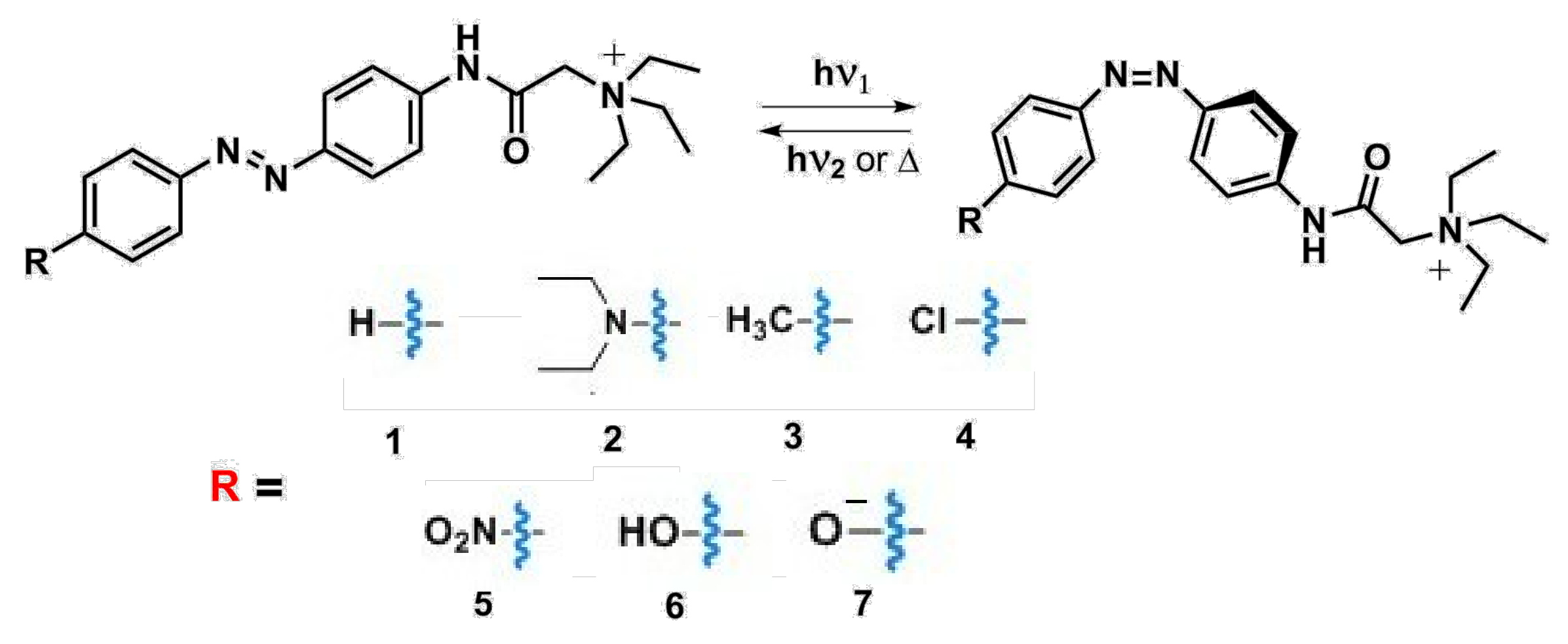
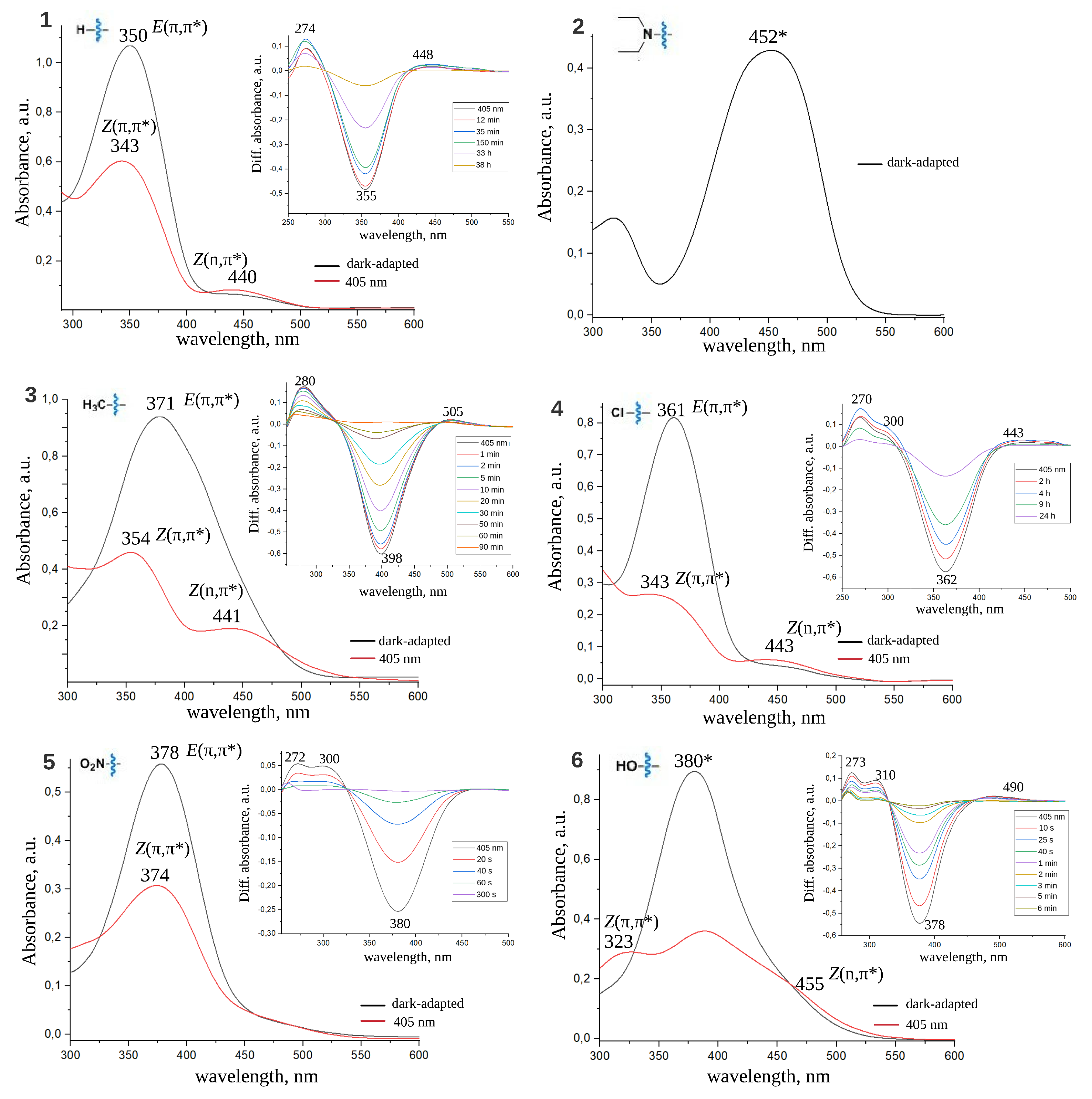
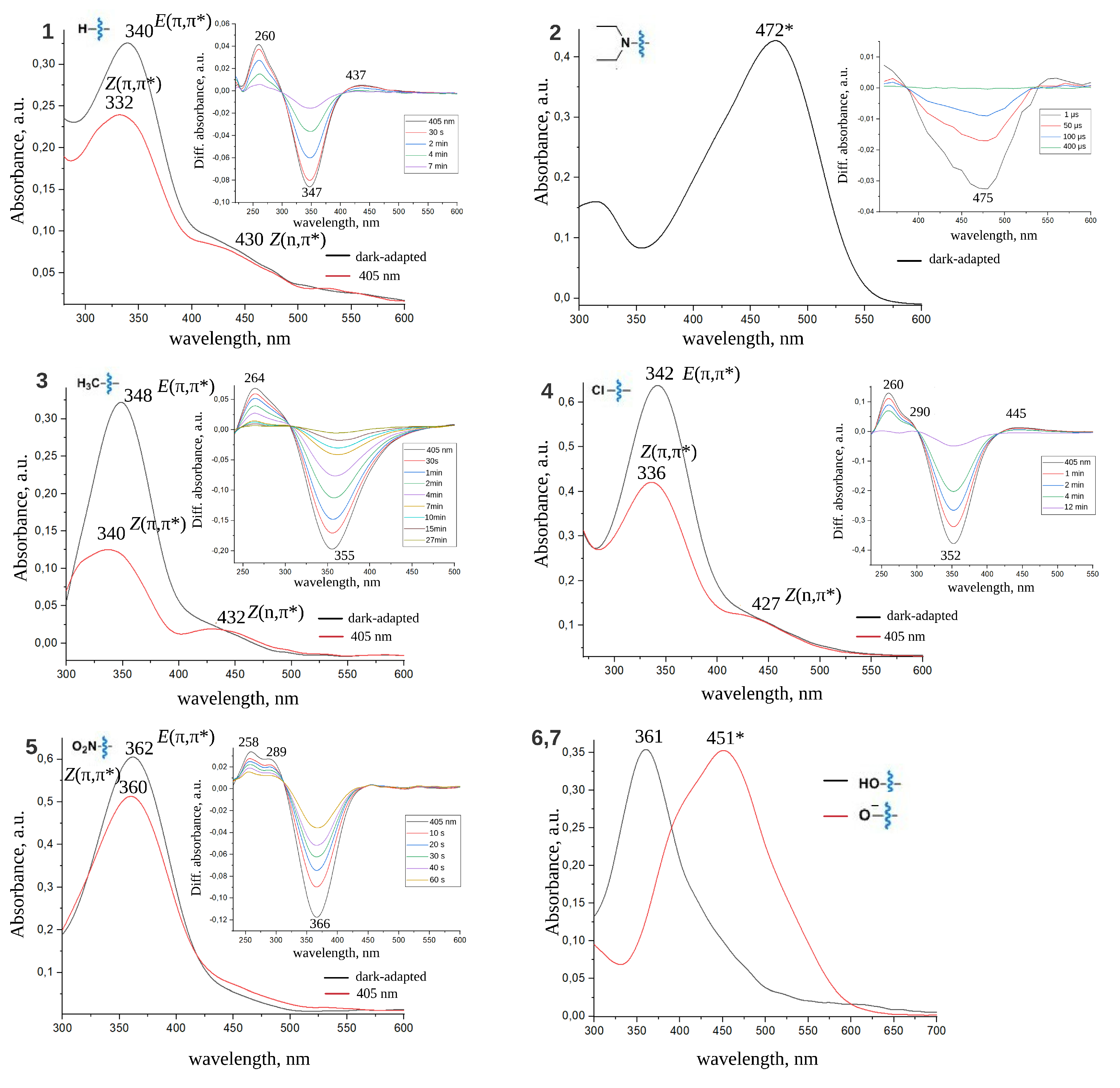
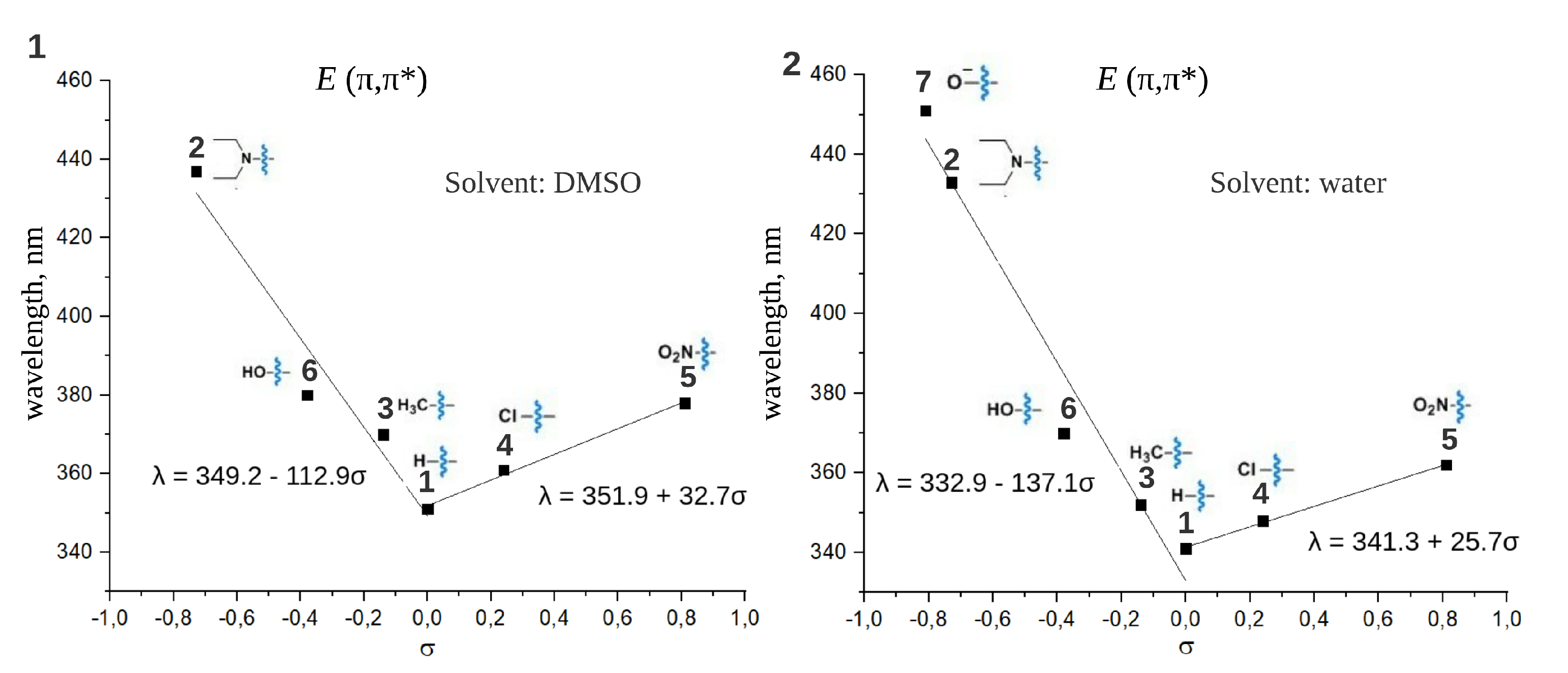

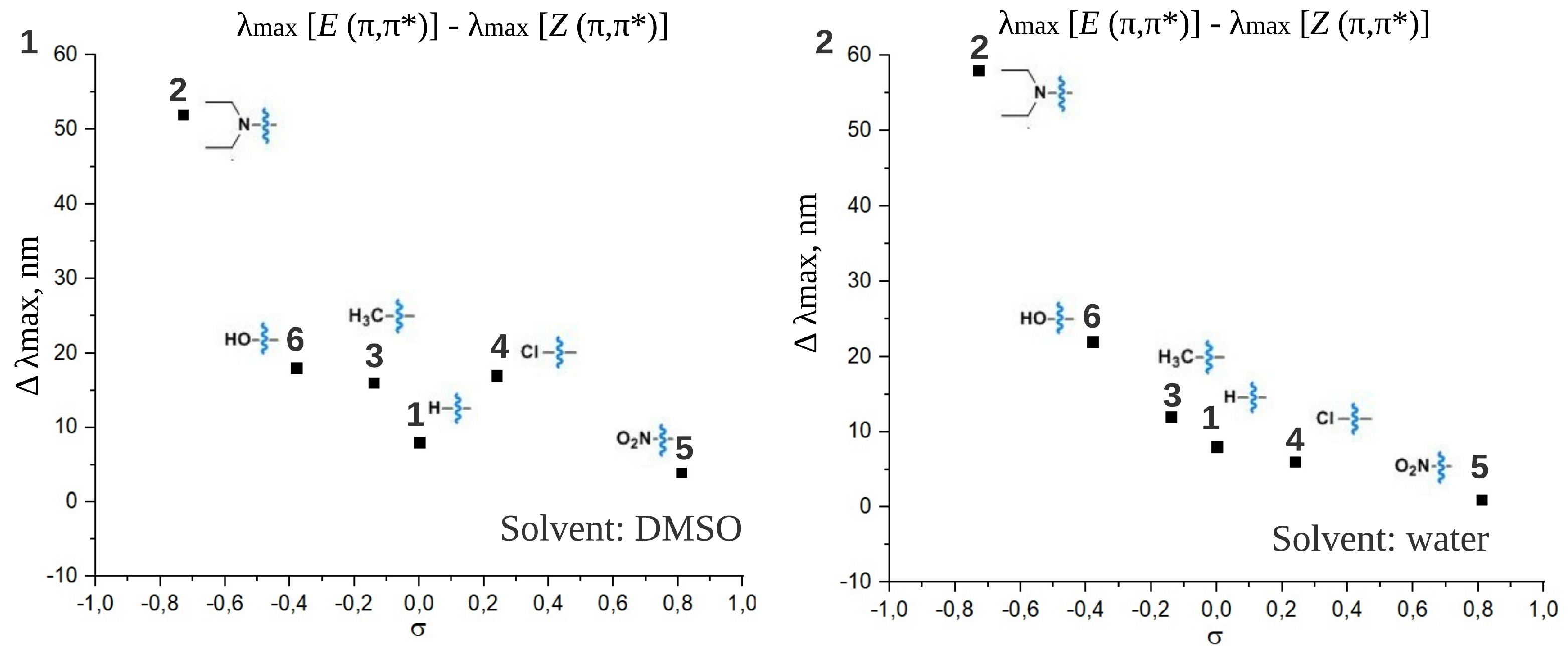

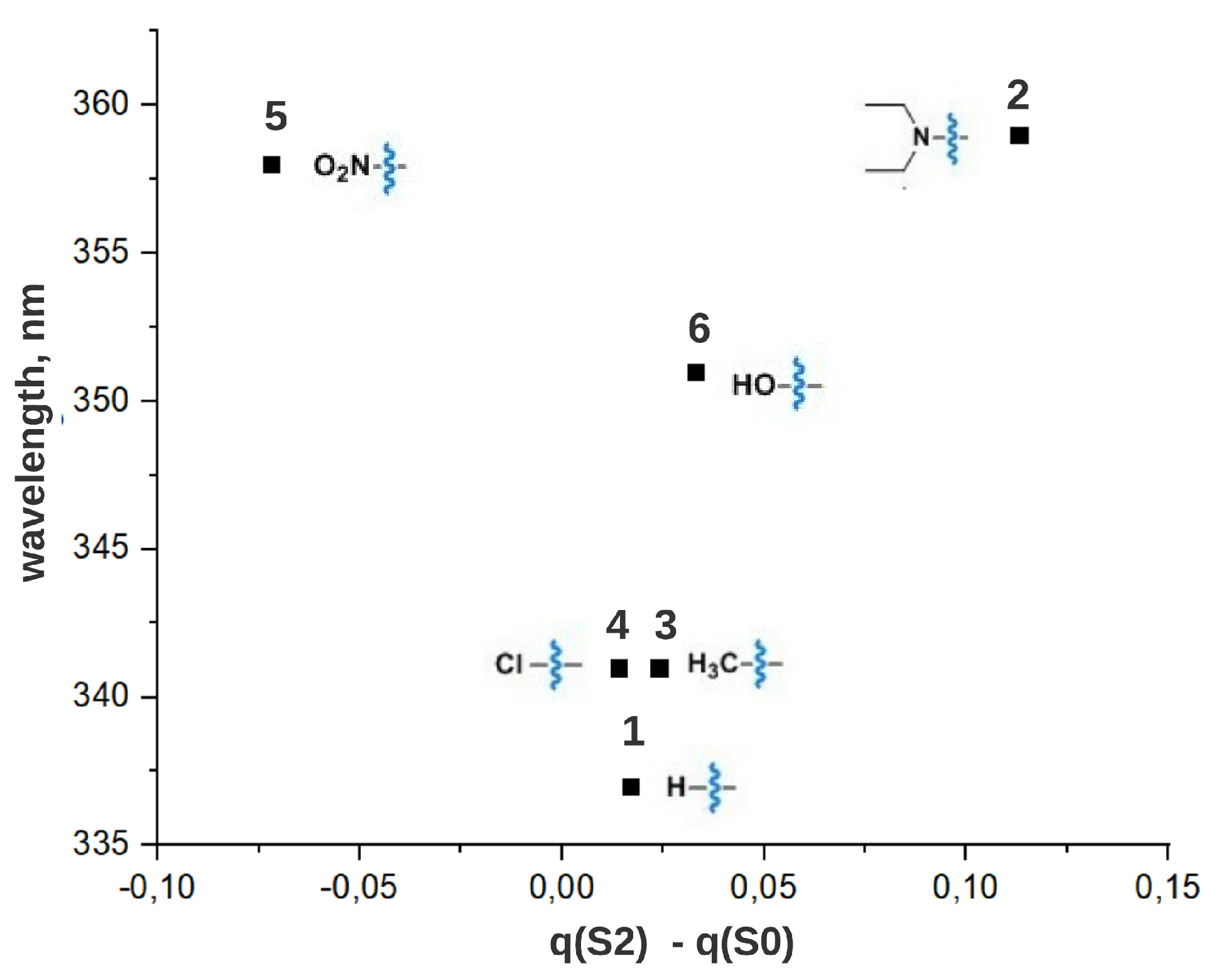
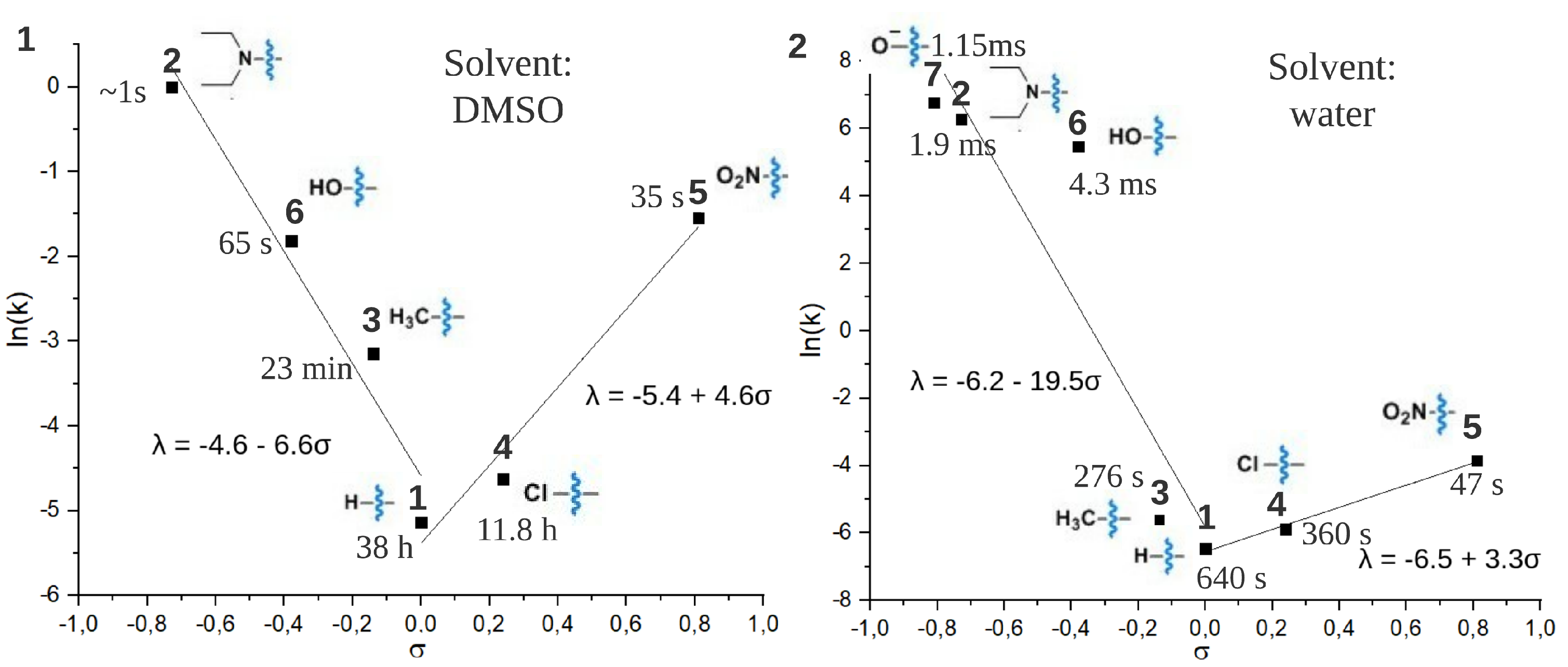

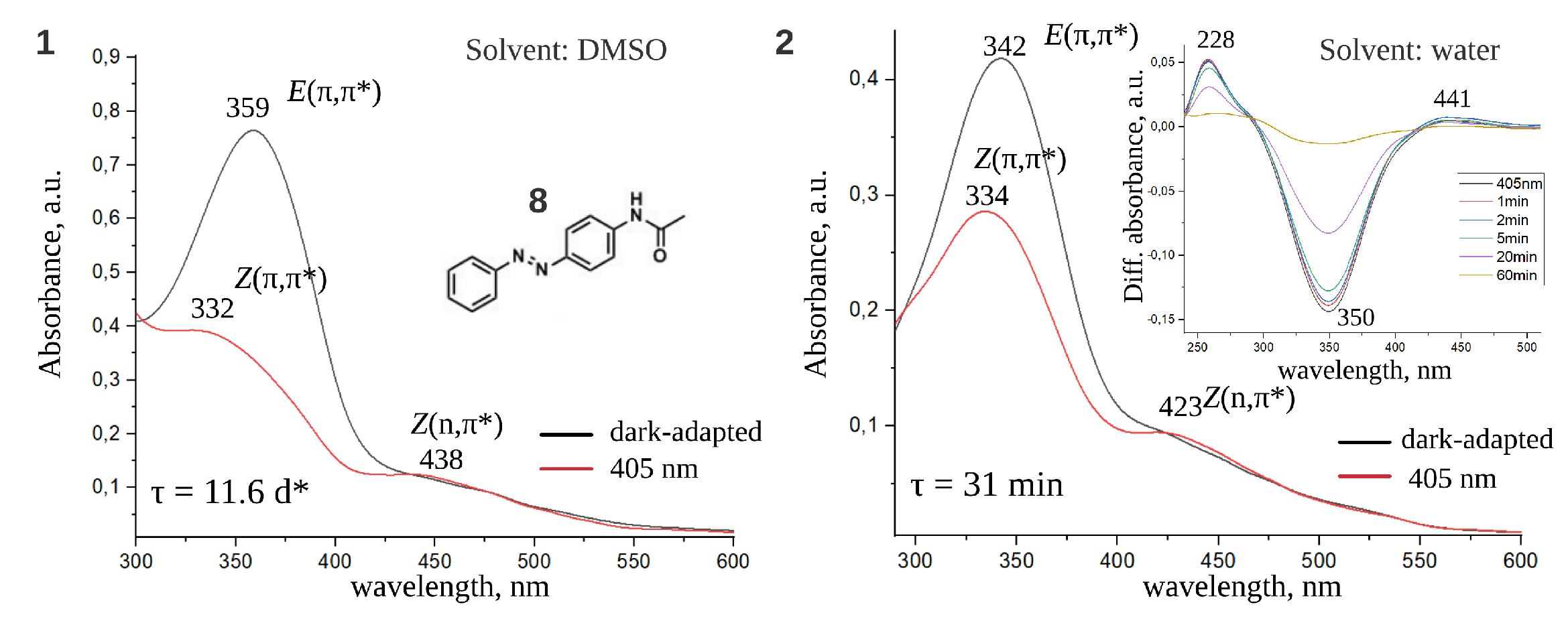
| Compound | [23] | () Water, nm | () DMSO, nm | () Water, nm | () DMSO, nm | () Water, nm | () DMSO, nm |
|---|---|---|---|---|---|---|---|
| 1 | 0.00 | 340 | 350 | 332 | 343 | 430 | 440 |
| 2 | −0.72 | 433 | 437 | - | 385 [10] | - | 465 [10] |
| 3 | −0.14 | 348 | 371 | 340 | 354 | 432 | 441 |
| 4 | 0.24 | 342 | 361 | 336 | 343 | 427 | 443 |
| 5 | 0.81 | 362 | 378 | 360 | 374 | - | - |
| 6 | −0.37 | 370 | 380 | 348 | 362 | 450 | 455 |
| 7 | −0.81 | 451 | - | 410 | - | - | - |
| 8 | - | 342 | 359 | 334 | 332 | 423 | 438 |
| Compound | [23] | (DMSO) | (Water, PBS) |
|---|---|---|---|
| 1 | 0.00 | 38 h | 640 s (pH = 7.4) |
| 2 | −0.72 | ≈1 s | 1.9 ms (pH = 7.4) |
| 3 | −0.14 | 23 min | 276 s (pH = 7.4) |
| 4 | 0.24 | 11.8 h | 360 s (pH = 7.4) |
| 5 | 0.81 | 35 s | 47 s (pH = 7.4) |
| 6 | −0.37 | 65 s | 4.3 ms (pH = 7.4) |
| 7 | −0.81 | - | 1.15 ms (pH = 11.3) |
| 8 | - | 11.6 d [11] | 31 min (pH = 7.4) |
Publisher’s Note: MDPI stays neutral with regard to jurisdictional claims in published maps and institutional affiliations. |
© 2021 by the authors. Licensee MDPI, Basel, Switzerland. This article is an open access article distributed under the terms and conditions of the Creative Commons Attribution (CC BY) license (https://creativecommons.org/licenses/by/4.0/).
Share and Cite
Strashkov, D.M.; Mironov, V.N.; Nikolaev, D.M.; Panov, M.S.; Linnik, S.A.; Mereshchenko, A.S.; Kochemirovsky, V.A.; Vasin, A.V.; Ryazantsev, M.N. Azobenzene/Tetraethyl Ammonium Photochromic Potassium Channel Blockers: Scope and Limitations for Design of Para-Substituted Derivatives with Specific Absorption Band Maxima and Thermal Isomerization Rate. Int. J. Mol. Sci. 2021, 22, 13171. https://doi.org/10.3390/ijms222313171
Strashkov DM, Mironov VN, Nikolaev DM, Panov MS, Linnik SA, Mereshchenko AS, Kochemirovsky VA, Vasin AV, Ryazantsev MN. Azobenzene/Tetraethyl Ammonium Photochromic Potassium Channel Blockers: Scope and Limitations for Design of Para-Substituted Derivatives with Specific Absorption Band Maxima and Thermal Isomerization Rate. International Journal of Molecular Sciences. 2021; 22(23):13171. https://doi.org/10.3390/ijms222313171
Chicago/Turabian StyleStrashkov, Daniil M., Vladimir N. Mironov, Dmitrii M. Nikolaev, Maxim S. Panov, Stanislav A. Linnik, Andrey S. Mereshchenko, Vladimir A. Kochemirovsky, Andrey V. Vasin, and Mikhail N. Ryazantsev. 2021. "Azobenzene/Tetraethyl Ammonium Photochromic Potassium Channel Blockers: Scope and Limitations for Design of Para-Substituted Derivatives with Specific Absorption Band Maxima and Thermal Isomerization Rate" International Journal of Molecular Sciences 22, no. 23: 13171. https://doi.org/10.3390/ijms222313171
APA StyleStrashkov, D. M., Mironov, V. N., Nikolaev, D. M., Panov, M. S., Linnik, S. A., Mereshchenko, A. S., Kochemirovsky, V. A., Vasin, A. V., & Ryazantsev, M. N. (2021). Azobenzene/Tetraethyl Ammonium Photochromic Potassium Channel Blockers: Scope and Limitations for Design of Para-Substituted Derivatives with Specific Absorption Band Maxima and Thermal Isomerization Rate. International Journal of Molecular Sciences, 22(23), 13171. https://doi.org/10.3390/ijms222313171







